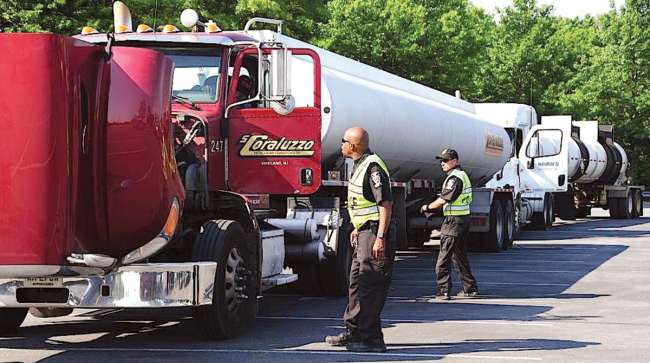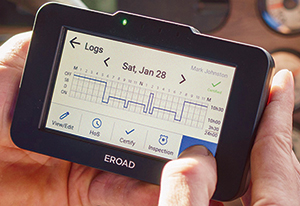Senior Reporter
CVSA Issues Bulletin to Mitigate False Inspection Violations From ELD Data Transfers

[Stay on top of transportation news: Get TTNews in your inbox.]
Technical issues that have been causing problems with the transfer of data from electronic logging devices to equipment used by roadside inspectors to check drivers’ hours-of-service records are the subject of a bulletin issued by the Commercial Vehicle Safety Alliance and are being studied by a pair of industry vendors.
An inspection bulletin issued Sept. 28 is intended to mitigate what CVSA called “common pain points” for drivers and carriers with transfer of ELD data in certain situations from drivers to inspectors that has led to a significant number of erroneous inspection violations over the past year or so, CVSA said.
The bulletin, which updates an earlier version, was issued after a long-term project led by ELD manufacturers Omnitracs and EROAD North America to find out why transfer and decoding of certain ELD data via the Federal Motor Carrier Safety Administration’s electronic records-of-duty status, or eRODS, was too often showing up on inspectors’ screens with incomplete, missing or confusing information.

In this episode, host Michael Freeze takes a look at the surprising ways trucking companies are building strong, resilient cultures and attracting talent that stays. Hear a snippet, above, and get the full program by going to RoadSigns.TTNews.com.
“When improperly deciphered, the eRODS may display ELD data in a way that leads to invalid violations, longer inspections and stress for drivers and fleet managers,” the two companies said in a joint statement. “The updated bulletin contains added clarification around the proper approach to interpreting data on eRODS, as well as recommendations for alternative methods for verifying mandatory data elements.”
Essentially, in certain instances data transferred via eRODS and displayed on inspectors’ screens has not matched data on a truck’s ELD screen.
“It stems from a file being transferred to eRODS, an inspector looking at it, and something is obviously cited on an inspection report,” Kerri Wirachowsky, CVSA’s director of the Roadside Inspection Program, told Transport Topics. “There’s about six or seven situations inside the bulletin that are problematic. They’ve been problematic over the past year or so. The hope is that the bulletin will help inspectors reduce the confusion.”
Carriers are required to submit information to FMCSA’s DataQ system on violations they believe may be incomplete or incorrect.
Wirachowsky said CVSA has scheduled a Nov. 12 webinar to educate inspectors about challenges associated with the issue.
“Part of the challenge is the information that’s interpreted by the FMCSA eRODS system doesn’t always tell the complete picture that may actually be available on the display of the ELD inside the truck,” Michael Ahart, vice president of regulatory affairs at Dallas-based Omnitracs told TT. “The items that are written up in this inspection bulletin are frequent occurrences and are a large nuisance, a significant nuisance, for motor carriers and drivers.”

An ERoad ELD. (ERoad)
Keith Halasy, EROAD’s director of marketing, said FMCSA has been responsive to problems with the eRODS transfer process that have been identified. Some motor carriers thought ELDs were causing the problem, which Halasy said is not the case.
“It’s a complex beast,” Halasy said. “There’s millions of trucks on the road and we’re trying to impact safety through regulation. It takes a lot of teamwork to make that effort successful.”
In a statement, an FMCSA spokesman said the agency is continuously looking at ways to improve its performance and strengthen commercial vehicle safety. “The electronic records-of-duty-status is no exception,” the spokesman said.
“There are times when the drivers are trying to do the right thing, the inspectors think they’re doing the right thing, and the eRODS is trying to process — but it doesn’t turn into the right outcome,” said Soona Lee, director of regulatory compliance for EROAD, based in Tualatin, Ore.
When inspectors see a potential problem, they should look at the vehicle display to verify a violation or get a printout of the ELD information from the driver, Lee said.
The initial inspection bulletin was written in 2017, when FMCSA adopted an ELD mandate for truckers.
“It focused on just basic operation of an ELD,” Ahart said. “Over the last three years we have learned so much more about how the eRODS system worked, and we certainly have experienced the levels of frustration — and have heard about the frustration — from enforcement, motor carriers and drivers. That was the impetus for us to enhance.”
The most common problem was the result of team drivers or shared vehicle drivers failing to power up and shut down their vehicles, according to Lee.
“Per the ELD mandate, values like trailer numbers or shipping documents are only placed on a power up or a shut down event,” Lee said. “It’s not an event in and of itself, so for eRODS to be able to process it, there needs to be a power cycle event — a power up or shut down.”
Some of the other more common problems addressed in the updated inspection bulletin have ranged from missing power unit numbers, trailer numbers, engine model years or shipping document information to missing or invalid vehicle identification numbers and miles driven.
Want more news? Listen to today's daily briefing:
Subscribe: Apple Podcasts | Spotify | Amazon Alexa | Google Assistant | More




